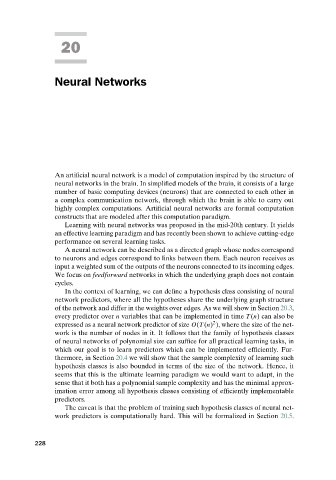Page 246 - Understanding Machine Learning
P. 246
20
Neural Networks
An artificial neural network is a model of computation inspired by the structure of
neural networks in the brain. In simplified models of the brain, it consists of a large
number of basic computing devices (neurons) that are connected to each other in
a complex communication network, through which the brain is able to carry out
highly complex computations. Artificial neural networks are formal computation
constructs that are modeled after this computation paradigm.
Learning with neural networks was proposed in the mid-20th century. It yields
an effective learning paradigm and has recently been shown to achieve cutting-edge
performance on several learning tasks.
A neural network can be described as a directed graph whose nodes correspond
to neurons and edges correspond to links between them. Each neuron receives as
input a weighted sum of the outputs of the neurons connected to its incoming edges.
We focus on feedforward networks in which the underlying graph does not contain
cycles.
In the context of learning, we can define a hypothesis class consisting of neural
network predictors, where all the hypotheses share the underlying graph structure
of the network and differ in the weights over edges. As we will show in Section 20.3,
every predictor over n variables that can be implemented in time T (n) can also be
2
expressed as a neural network predictor of size O(T (n) ), where the size of the net-
work is the number of nodes in it. It follows that the family of hypothesis classes
of neural networks of polynomial size can suffice for all practical learning tasks, in
which our goal is to learn predictors which can be implemented efficiently. Fur-
thermore, in Section 20.4 we will show that the sample complexity of learning such
hypothesis classes is also bounded in terms of the size of the network. Hence, it
seems that this is the ultimate learning paradigm we would want to adapt, in the
sense that it both has a polynomial sample complexity and has the minimal approx-
imation error among all hypothesis classes consisting of efficiently implementable
predictors.
The caveat is that the problem of training such hypothesis classes of neural net-
work predictors is computationally hard. This will be formalized in Section 20.5.
228

